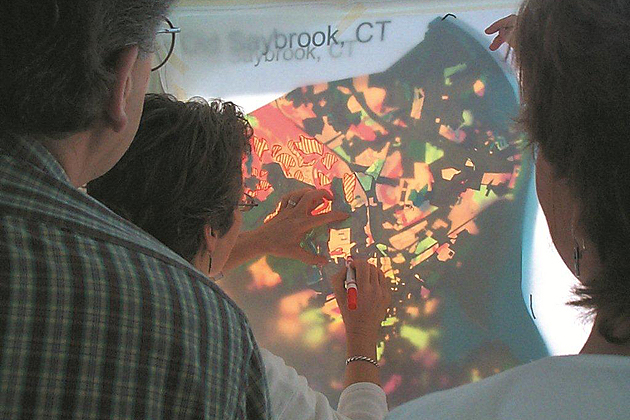UConn’s Center for Land Use Education and Research (CLEAR) is a collaboration between the Department of Natural Resources and the Environment and the Department of Extension – both part of the College of Agriculture and Natural Resources – and the Connecticut Sea Grant Program.
CLEAR’s mission is to provide information, education, and assistance to land-use decision makers in support of balanced growth and natural resource protection.
An important component of CLEAR is the Nonpoint Education for Municipal Officials program (NEMO) that is celebrating its 20th anniversary this year.
Mike Dietz, assistant extension educator-in-residence in the Department of Extension and NEMO’s director, recently sat down with UConn Today to explain the importance of the program to Connecticut residents.
_____________________________________________________________________________________

Q. NEMO is an acronym for Nonpoint Education for Municipal Officials. That’s quite a mouthful. Can you explain what nonpoint education is and why it’s important to municipal officials?
A. In the world of natural resource protection, nonpoint refers to water pollutants that come from many different sources. This type of pollution includes rainfall or snowmelt that moves over and through the ground picking up natural and human-made pollutants and eventually depositing them into water sources. Nonpoint pollution can include excess fertilizers and herbicides from a rural source, or oil, grease, and toxic chemicals from urban runoff. That type of thing. The opposite is point source pollution which comes from identifiable sources such as pipes from factories or sewage treatment plants.
The reason municipal officials need to be knowledgeable about nonpoint source pollution is that they’re the ones on a local level who are responsible for how land gets developed. For example, natural resource protection and environmentally sound land use planning. With nonpoint pollution it’s not just a matter of identifying a source of pollution and shutting it down. It can be a complex problem and often there aren’t any simple answers.
Q. What’s UConn’s role? What happened 20 years ago to spur the creation of NEMO?
A. The lack of readily available information seems hard to believe now, but going back 20 years people serving on local boards and commissions involved in long-range planning usually had little or no training in environmental policy and no easy way to get it. There was a growing interest in conservation and the environment, but not a lot of readily available information. The internet … really the web … as we know it, was in its infancy. But as an outgrowth of Sea Grant and a study that used remote sensing and geographic information system (GIS) technologies to explore Connecticut’s coastal communities, we realized we could provide the same type of assistance to other towns and cities.
Q. How do you do this?
A. Our basic method of operation is direct communication with town officials. We answer questions from planning and zoning boards. We talk to development officials. We hold workshops and webinars and have developed a number of accessible web tools that local officials can use to help understand their landscape and what’s happening to it.

With time, a number of other programs evolved from NEMO, such as our Geospatial Training Program that trains people in the use of technologies such as GIS, remote sensing, and Global Positioning Systems (GPS). In the early 2000’s, the principals from these related projects got together and formed CLEAR.
Q. What kind of things have you done over the years?
A. Over the last 20 years, we’ve provided direct assistance to about 75% of the State’s 169 cities and towns, and that includes things like helping the town of Waterford develop a plan for managing runoff from a large commercial development, working with the Candlewood Lake Authority in western Connecticut to develop a Lake Protection Zone (LPZ) for land use immediately around the lake, and even working with towns in developing ‘green’ parking lots … ones that use bioretention and pervious pavements to reduce the volume of storm water runoff from parking lots … and improving the quality of the water that does get into the environment.
Q. This all sounds pretty high tech. What else is in your arsenal?
A. As I’ve said, we have a lot of web tools to offer town officials, planners, and citizens. NEMO’s Low Impact Development Inventory is an on line resource that provides real-life examples of low impact development practices in Connecticut towns. In addition, we have web-based mapping tools like CT ECO which we developed in partnership with the Conn. Department of Energy and Environmental Protection, and which contains just about all the natural resource information available for Connecticut.
Q. You strive to be impartial by presenting factual information, but environmental issues can be volatile. Do you ever find you’re in an adversarial relationship with town officials or with people interested in developing a certain parcel of land who don’t necessarily welcome your recommendations?
A. We don’t weigh in on conflicts over specific parcels, or testify at public hearings. Our assistance always comes in the form of education, not as part of the land use decision-making process.
We also do not force our programs on towns; we make staff and commission members aware of what we offer, and if they request our assistance we work with them to develop an educational program that best fits their town, and the issues that they’re grappling with.
That’s not to say that we don’t sometimes have a pretty lively, and sometimes contentious, discussion session as part of our workshops.




